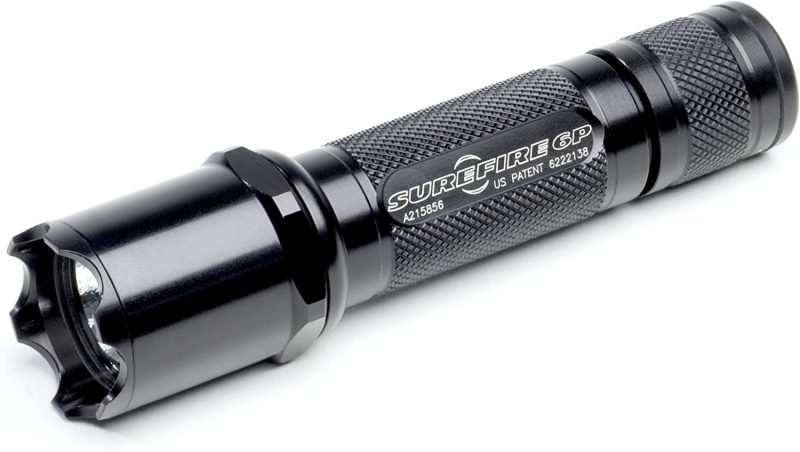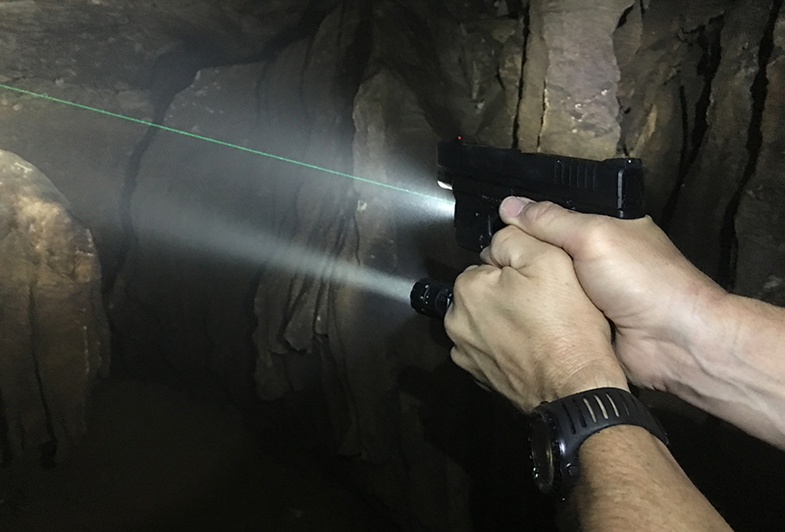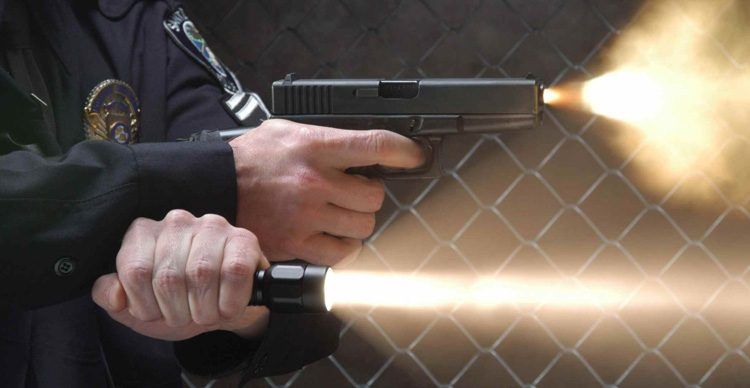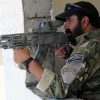Being able to function proficiently in darkness is important to home and personal defense capability. Yet, many people who keep or carry a handgun do not adequately equip or train themselves to perform effectively and safely in low light conditions.
High-intensity flashlight
A high-intensity flashlight is a mission-critical tool for home defense and should also be considered by those licensed to carry a concealed handgun in public. A flashlight enables you to illuminate and visually identify potential threats. A flashlight also permits you to more safely confront a threat at gunpoint and engage a threat by gunfire, if needed, during low light and darkness conditions. These are the primary purposes of a flashlight when used in a personal defense context.
Surefire 6P
We feel the Surefire 6P flashlight, by Laser Products, is the best flashlight you can use for home and personal defense applications. The 6P is a small, lightweight but powerful flashlight. (Surefire also offers three other models based on the 6P design: the C2 Centurion, E2 Executive, and G2 Nitrolon flashlights.) The 6P style flashlight easily fits into the palm of your support hand and is powered by two Duracell CR123A lithium camera batteries. It’s pushbutton momentary On/Off switch is conveniently located on the tail cap, the one location where it can be quickly located and manipulated without hunting to find it. It is also one of the most inexpensive SureFire flashlights offered by Laser Products.

Laser Products also offers a slightly longer Surefire flashlight, the 9P (now discontinued but replaced by the D3 Defender), which uses three lithium batteries and is brighter than the 6P. The 6P-type is probably the best choice for most people, but the 9P/D3 might be easier for you to manipulate if you have large hands.
Also, the 9P/D3 can also be converted to operate on only two lithium batteries by changing the lamp assembly from model P90/P91 to model P60/P61 and purchasing a Surefire model Z20 DL123A battery spacer (providing the same illumination performance as the 6P while allowing you to save money on batteries). Users can buy replacement batteries for the 6P style and 9P/D3 flashlights from supermarkets and discount department stores like Wal-Mart or K-Mart.
Surefire Combatlight
The specialty SureFire 6Z, C2, G2Z, M2, and Z2 two cell Combatlight flashlights and 9Z, C3, M3, and Z3 three cell Combatlight flashlights, which Laser Products promotes as being optimal for use with handguns. (These lights are more expensive than the 6P/D2/G2 and 9P/D3 models.) The Combatlights are meant to be employed using Surefire’s proprietary two-handed “Rogers/Surefire assisted flashlight technique.”
Finally, the Surefire 3P/E1 flashlight (too small) and the rechargeable Surefire 6R, 8X, and 9N flashlights. Aside from being more expensive than any of the battery-powered lithium flashlights described above, the 6R, 8X, and 9N can be dangerous in home and personal defense situations. The reason is that the rechargeable nickel-cadmium batteries do not indicate that they are about to lose power. Your first clue that the batteries are exhausted is when the beam suddenly dims and then extinguishes in seconds.
Whereas with replaceable lithium batteries, when the beam starts to dim from bright white to yellow, you have ample warning that it’s time to replace them. Lithium batteries are good for about an hour of continuous use, and they start to go dim after about 35-45 minutes of load time. They maintain a charge for years, compared to the slow and constant electrical discharge of rechargeable batteries.
What makes the Surefire 6P (and D2, E2 & G2 models) and 9P (and D3) flashlights most desirable are their lower price and the ability to easily and inexpensively modify them for personal defense and concealed carry use, making them superior in overall tactical utility when compared to the 6Z (C2, M2 & Z2) and 9Z (C3, M3 & Z3) Combatlight models.
We also feel a modified Surefire 6P (and D2, E2 & G2 models) flashlight is superior to a dedicated handgun mounted flashlight because it is much less expensive and versatile. The 6P-type flashlight is safer because you don’t have to point the muzzle of your handgun toward anyone to determine if they are a threat or not.
The Surefire 6P (D2 & G2) and 9P (D3) flashlights can be modified by adding a tail cap lanyard ring and an adjustable battle carry lanyard. With this modification, the flashlight can be securely attached to the palm of the support hand in the proper position and orientation to use instantly. Still, it also leaves the fingers of the support hand free to perform other tasks when needed immediately.
Harries two-handed handgun/flashlight shooting technique
The battle carry lanyard requires using the Harries two-handed handgun/flashlight shooting technique, which is a more natural and comfortable manner for grasping the flashlight than the Rogers/Surefire method. The Harries technique is similar to the Weaver Stance, except that the back of the support hand is pressed firmly against the back of the shooting hand. This technique enables the support hand to hold and operate the flashlight while simultaneously providing isometric stability to the shooting hand.
To clear a handgun stoppage when using a full-size Mag-Lite-type flashlight, you usually stow the flashlight under the armpit of your gun hand to free your support hand to manipulate the gun. With Surefire Combatlight style flashlights, you’re supposed to release your grip on the flashlight to free your support hand and allow the Combatlight to dangle unrestrained under your wrist on its lanyard. At the same time, you manipulate the gun to clear the stoppage.

With both the Mag-Lite flashlight and 6Z/9Z Combatlights, after you’ve cleared the weapon malfunction, you then have to grab the flashlight in your support hand, orient it in the proper position to use, and then acquire a two-handed shooting stance to re-engage the target with precision aimed gunfire. The same process is required when you need to reload your gun or any task requiring you to let go of the flashlight to use your support hand.
When using a 6P/9P-type flashlight equipped with a battle carry lanyard, should you experience a handgun stoppage while you’re under attack, the support hand can be instantly used to clear the jam without fumbling with the flashlight at all. You can re-engage the target once the jam is clear using the Harries technique. The same is true for reloads and any other task that requires you to have the fingers of your support hand free.
The battle carry lanyard exploits economy of motion because the flashlight is securely attached to the palm of your support hand in a manner that does not require the fingers to maintain a grasp on it. Thus, your support hand is free to perform additional tasks as needed quickly. The flashlight barely interferes with the dexterity of the hand. If illumination is required, it can be instantly employed without the clumsy mishandling of the flashlight.





